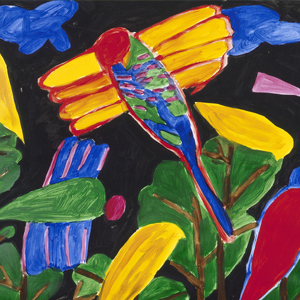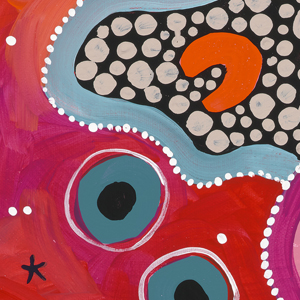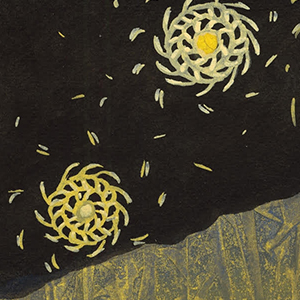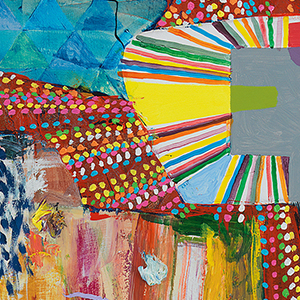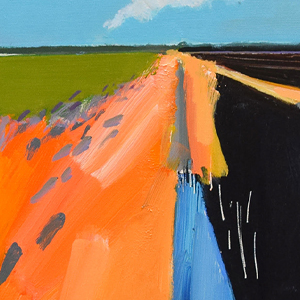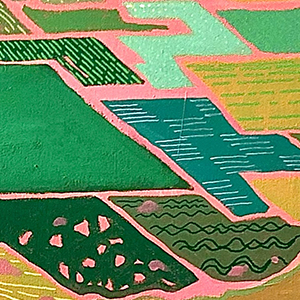
PURSUING VIRTUE
The Flourishing Runner
Sabrina B. Little
Artwork: “In the Meantime” by Claire Desjardins © 2017
There is an uneasy place I often visit when I run.
It is a liminal space, or a border between two territories. On one side of the border are edifying discomforts—full of the kinds of chosen suffering my body can absorb and grow from. On the other side are unproductive pains and destructive suffering. On this side of the border are injuries, burnout, and other ill-effects for my body and mind long-term.
I want to securely position myself in the land of edifying discomforts, drawing as close to the border as possible without crossing over (a The Price Is Right calculation for my body). This way, I can maximize my potential as an athlete without overstepping my physical limits.
But, in practice, this is not easy to do. The border line is often blurry and difficult to detect while I am training hard. Also, its location shifts across a season, and year-to-year, as my fitness waxes and wanes. Being my best, yet not broken, is risky business. I sometimes get it wrong.
Liminal Spaces
There is Greek myth that captures the approach of one’s limits—the myth of Daedalus and Icarus. Daedalus, an expert craftsman, supplies Icarus with a pair of wings constructed of feathers and wax to escape from King Minos. Icarus is instructed to “take the middle way”—flying neither too high nor too low, lest moisture or the scorching sun destroy his wings (Ovid, VIII. 183–235). These are imprecise instructions for anyone, let alone a man who has never flown before, and Icarus does not heed them.
Icarus flies too close to the sun, and his wings melt. But I imagine that his wings do not melt in a single instant. Instead, they probably melt slowly over minutes and seconds as Icarus ascends through a liminal space, pressing further, uncertain where the boundary lies between ascendency and peril. Then, like an athlete who has pressed too far, Icarus falls from lofty heights.
The Flourishing Athlete
There is something that happens in the weeks preceding the Olympic Games and World Championships. Announcements begin to trickle out—at first slowly, then en masse—of athletes who will not make it to the starting line. Their announcements are similar: I pushed myself further than I intended. I was faster, stronger, and more capable than I have ever been . . . until I lost my ability altogether. I pushed too far and came undone.
In my own experience, I broke an American record in my first World Championships. In my second, I broke my foot. In both cases, I straddled a line between preparation and destruction, not from hubris (as is often attributed to Icarus), but from some combination of inexperience and fear of not maximizing my abilities. Like Icarus, trying to abide the “middle way” is perilous business—especially when you are new to flying, and particularly in a sport where ascension depends on quieting the inner voice that tells you to slow down, rest, or fly a little bit lower.
To a certain extent, it seems that pressing and (sometimes) overstepping limits to our peril is part of the process of athletic mastery. It is difficult to know where your potential lies if you never push far enough to encounter your physical limits. Even the most practiced athlete sometimes pushes too far. But it also seems that there are certain ways we can be purposeful in how we occupy the sport—to take our humanity seriously, while striving greatly. We can acknowledge and embrace the existence of certain limitations in a human life. And we can flourish, even as we aspire to great feats.
What does it look like to take humanity seriously in the context of sport? And how can we flourish as human beings, while also pressing limits and maximizing potential for peak performance? I have four ideas.
1. Make rest a habit.
Flying too close to the sun has physical costs. Sometimes these costs are felt immediately. We hit a proverbial wall, and our bodies falter under the strain.
Other times, these costs are delayed. Over months or years, we push ourselves too far without relief. We run an unsustainable number of miles, lift heavy weights, pay outsized attention to training, or insufficiently rest. At first, we may excel. We may run further or faster than we ever have! But eventually—as we ascend through a liminal space—our wings melt. We experience negative repercussions for our bodies long-term.1
Clearly, we do not want to arrive at that point—for the sake of our health, or for performance. However, as I have said, our limits are often difficult to discern. It is challenging to tell the difference between good tired and bad tired, or edifying discomforts and injury.2 Sometimes internal alarm bells sound in difficult workouts, telling us to stop when we should have persevered. Other times, adrenaline permits us to abide in difficulties that should have alarmed us. Our internal barometers are fickle at lofty heights.
Because our physical limits are fuzzy, it can be helpful to build a habit of rest, rather than waiting to rest until we feel that we need to. We can build moments of rest into our daily routines or perhaps schedule a day completely free of training each week.
We can also structure our years to include fallow seasons—periods of time in which we reduce training to restore our bodies and minds. Making rest a routine takes the pressure off of us, from having to recognize the signs of impending injury or fatigue. It can prevent us from digging ourselves into too deep of a hole through momentum or fatigue accretion.
2. Name (and embrace) the ways in which you are limited.
Often, when we speak of limits as athletes, we mean bodily ones. We mean aerobic constraints, maximal cadence, heart rate, and muscle strength. These are the limits we aim to extend, and we can do so, to a certain extent, through training. But there are other kinds of limitations in the human life. For example, some of our limits are people. In an essay by Wendell Berry, he describes cultural limits. These include family, friendships, and “self-restraints implied by neighborliness.”3
Berry writes that there are people in our lives to whom we have obligations. We have responsibilities as citizens and neighbors, and we owe our friends loyalty, time, and attention. These obligations are a kind of limit that we sometimes tread on when we go “all in” in sports (or in any serious endeavor). If we are not careful, we compromise relationships in our striving.
There are additional limits besides these. For instance, we have moral constraints.4 There are certain kinds of striving that are out of bounds in a good human life. For example, to win by cheating or to strive insatiably in a way that impedes our ability to see and appreciate worthier goods, should not characterize how we compete. Philosopher David McPherson also names existential limits—limits with respect to the given, or to what exists.5 Respecting our existential limits as athletes involves gratitude that constrains our striving. It also involves recognizing what we can control and what is out of our hands.
As athletes, we can choose to repeatedly transgress the outer limits of our ability. We can be frustrated that we are embodied beings who require rest and are bound by relationships, morality, and our creaturely status. Or we can make peace with these constraints as part of a rich human life. We can be purposeful in embracing rest as part of the rhythm of training and not being forgetful of our relationships as we aim for lofty heights.
3. Grow in contentment.
In his recent book, David McPherson describes a set of excellences he calls the “limiting virtues.”6 These are concerned with recognizing proper limits in a human life. One such virtue of particular relevance for the striving athlete is contentment.
Striving can be insatiable. There are always bigger stages to compete on, and every time we step across a finish line, there is another start line to prove ourselves.
In Plato’s Gorgias, we meet Callicles’ tyrant—a man whose life is dominated by an insatiable appetite for pleasure. Socrates compares this tyrant to a leaky jar that is constantly filled but never full, and to a person who itches constantly without ever experiencing relief.7 Striving can take on this character. We can feel compelled to keep pressing toward our performance objectives—to draw closer to our limits. We can become like the insatiable tyrant in our striving. Contentment is an important virtue here.
McPherson defines contentment as the virtue of “knowing when enough is enough, of not wanting more than is needed for a good life.”8 It is not at odds with striving. Rather, contentment provides secure grounds for our striving. It involves a kind of recognition of gifts and opportunities that is not contingent upon satisfying our objectives.
There are other key virtues that help us to embrace our limits. One is humility, which permits us to “recognize and live out our proper place in the scheme of things.”9 The humble runner can acknowledge her weaknesses and learn from mistakes. Another is temperance, which involves having well-ordered desires, such that you are not ruled by your appetites and can focus your attention on worthier things. A temperate runner would not be marked by an insatiable desire to win. Her love of the sport would be well-ordered, rather than obsessive.
4. Have a long view.
The first thing I advise younger athletes who are becoming invested in distance running is this: Pursue a mentor from outside of the sport, preferably one who is much older than you.
There is a kind of presentism that animates the life of the athlete. Athletic careers are short. We want to maximize our few good years of peak fitness and the opportunities we have to run quickly when they are available to us. This can lead us to develop a myopic, single-minded pursuit of excellence in running that compromises opportunities outside of the sport, a wide range of interests, or a healthy life long-term.
One way to override this bias is to have someone you trust speaking into your life from outside of the sport, such as an older, non-running mentor. Maybe they will not understand everything about running or your drive. But one thing I have learned is that what looks like commitment from inside the sport sometimes looks like obsession from without. And what often looks like toughness from within looks like imprudence from without.
Whether or not the athlete is really obsessed, imprudent, or is otherwise occupying the sport in a detrimental way, is not always clear. But it is valuable to have someone who wills the athlete’s good asking hard questions so that the athlete is prompted to self-examine. Mentors aside, athletes should examine their running with a view to flourishing, health, and repercussions long-term.
Final Thoughts
To some extent, pressing and sometimes overstepping limits to our peril is part of the process of athletic mastery. It is difficult to know where our potential lies if we never push far enough to encounter our physical limits. But there are ways we can be purposeful in how we occupy the sport—to take our humanity seriously, while striving greatly. We can acknowledge and embrace our limits, and we can flourish, even as we aspire to great feats.
Notes
- Sabrina B. Little. (2021). Limitless. iRunFar.com.
- For an expanded explanation of suffering and flourishing, see Chapter 7 of S. B. Little (2024). Oxford University Press.
- Wendell Berry (2008). “Faustian Economics.” Harper’s Magazine.
- David McPherson. (2022). The Virtues of Limits. Oxford University Press, 46-7.
- Ibid., 5.
- Ibid.
- Plato. Gorgias 494c.
- David McPherson. (2022). The Virtues of Limits, 3.
- Ibid., 2.

Sabrina Little is an elite distance runner and an assistant professor in the department of Leadership and American Studies at Christopher Newport University. A 5-time national champion, Sabrina previously held the U.S. record in the 200k and the 24-hour run. Her first book, The Examined Run, is forthcoming in 2024 with Oxford University Press.
Spring 2024
Part I: Pursuing Virtue
L. Gregory Jones
Sabrina B. Little
Kelli Reagan Hickey
Jesse S. Summers
Interlude: Purposeful Pursuits
Howard Gardner
Part II: Pursuing Vocation
Clayton Spencer
James Coleman, Jr.
James and Margaret Plews-Ogan
Carolyn Woo
MORE





